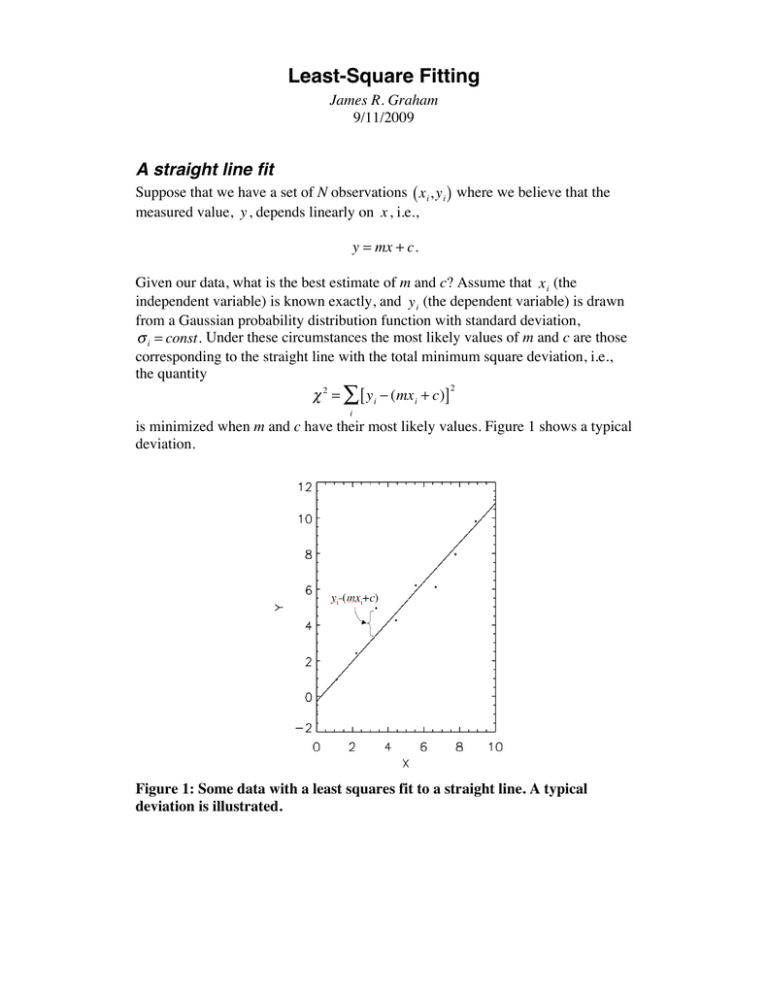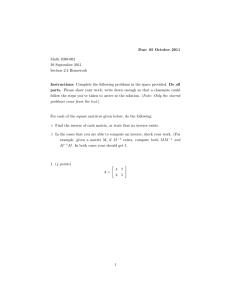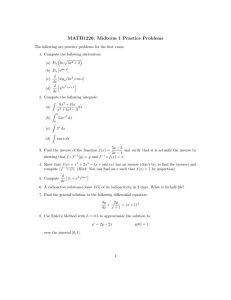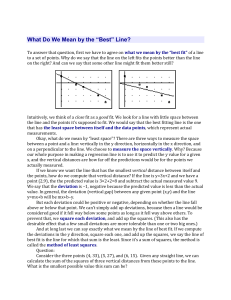Least-Square Fitting
advertisement

Least-Square Fitting James R. Graham 9/11/2009 A straight line fit Suppose that we have a set of N observations ( x i , y i ) where we believe that the measured value, y , depends linearly on x , i.e., y = mx + c. Given our data, what is the best estimate of m and c? Assume that x i (the independent variable) is known exactly, and y i (the dependent variable) is drawn from a Gaussian probability distribution function with standard deviation, σ i = const. Under these circumstances the most likely values of m and c are those corresponding to the straight line with the total minimum square deviation, i.e., the quantity 2 χ 2 = ∑ [ y i − (mx i + c)] i is minimized when m and c have their most likely values. Figure 1 shows a typical deviation. Figure 1: Some data with a least squares fit to a straight line. A typical deviation is illustrated. Mathematically, the best values of m and c are found by solving the simultaneous equations, ∂ 2 ∂ 2 χ = 0, χ = 0. ∂m ∂c Evaluating the derivatives yields ∂ 2 ∂ 2 χ = yi − (mxi + c)] = 2m ∑ xi2 + 2c∑ xi − 2∑ xi yi = 0 [ ∑ ∂m ∂m i i i i ∂ 2 ∂ 2 χ = ∑ [ yi − (mxi + c)] = 2m ∑ xi + 2cN − 2∑ yi = 0. ∂c ∂c i i i Which can conveniently be expressed in matrix form, ⎛ ⎜ ⎜ ⎝ ∑x ∑x ∑x N 2 i i i ⎞ ⎛ ⎛ ⎞ ⎟ m =⎜ ⎟ ⎜⎝ c ⎟⎠ ⎜ ⎠ ⎝ ∑x y ∑y i i i ⎞ ⎟ ⎟ ⎠ and solved by multiplying both sides by the inverse, ⎛ m⎞ ⎛∑ x i2 ⎜ ⎟ = ⎜⎜ ⎝ c ⎠ ⎝ ∑ xi −1 ∑ x ⎞⎟ ⎛⎜∑ x y ⎞⎟. N ⎟⎠ ⎜⎝ ∑ y ⎟⎠ i i i i The inverse can be computed analytically, or in IDL it is trivial to compute the inverse numerically, as follows. Example IDL ; Test least squares fitting by simulating some data. nx = 20 ; Number of data points m = 1.0 ; Gradient c = 0.0 ; Intercept x = findgen(nx) ; Compute the independent variable y = m*x + c + 1.0*randomn(iseed,nx) ; ; ; ; ; plot,x,y,ps=1 Compute the dependent variable and add Gaussian noise ; Construct the matrices ma = [ [total(x^2), total(x)],[total(x), nx ] ] mc = [ [total(x*y)],[total(y)]] ; Compute the gradient and intercept md = invert(ma) ## mc ; Overplot the best fit oplot, x, md[0,0]*x + md[0,1] end See Figure 2 for the output of this program. Figure 2—Least squares straight line fit. The true values are m = 1 and c = 0.




